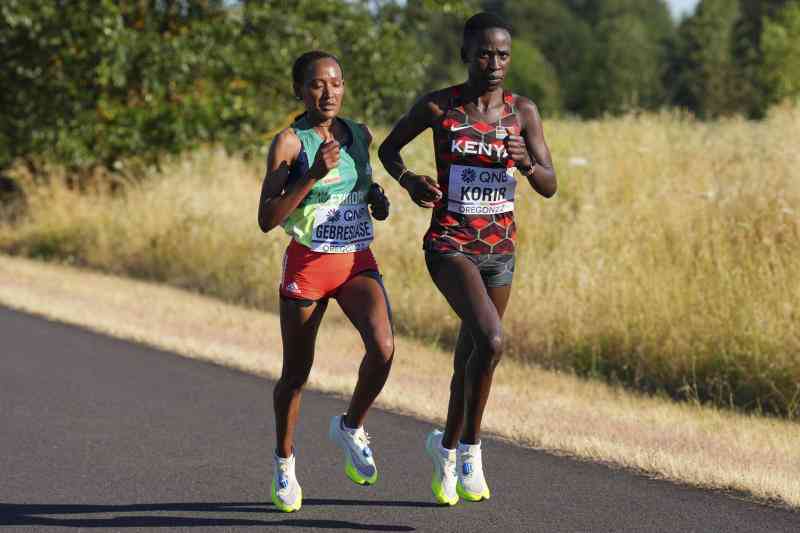By Wandera Ojanji
When the Kenya Agricultural Research Institute (Kari) introduced gadam - an early maturing white sorghum variety - as a food crop developed for arid and semi-arid areas in 1972, many farmers shunned it in favour of maize.
But 40 years later, due to climate change, gadam is steadily replacing maize as the main commercial and staple food crop in the region.
Interestingly, the current success comes after the gadam was re-introduced not as a food crop, but an industrial crop for beer production.
Surprised by the turn of events, researchers from the Kenya Arid and Semi-Arid Lands Research Programme (Kasal), who have been involved in the development of gadam sorghum, offer some insights into the new developments.
Kasal is an EU-funded project implemented by Kari.
Mr David Karanja, the principal investigator Kasal Gadam Sorghum Project, notes that attempts to re-introduce the variety in Eastern Kenya in 2004 got mixed reactions.
"Although the yields were good, lack of markets, low producer prices and bird damage were major constraints to increased sorghum production," says Karanja.
Dr David Miano, Kasal coordinator, says addressing these three constraints has greatly contributed to the growing popularity of gadam sorghum in the region.
Certified seeds
Capitalising on the recent trends in the brewing industry, where sorghum is becoming a popular alternative to barley in beer making, Kasal re-introduced gadam as a commercial crop for communities in the Asal areas in 2008.
As luck would have it, East African Breweries Limited (EABL), the largest malt beer maker in the region, agreed to use sorghum in its brewing process, creating a ready market for the farmers.
Experts say gadam has the desired qualities for beer making; 75 per cent carbohydrates compared to 67 per cent in barley and 66 per cent in maize, making it a good alternative source for starch.
In addition, it has high levels of fermentable sugars and low levels of oil and proteins, which makes it good for industrial processing, according to Karanja.
Dr Miano says they decided to bring together EABL, Smart Logistics, Equity Bank, Ministry of Agriculture and the Kari Seeds Unit (KSU) to tackle the small-scale production dilemma.
Stay informed. Subscribe to our newsletter
To ensure that farmers delivered quality yields, Kasal in collaboration with Kari scientists and staff from Ministry of Agriculture trained the small-scale farmers on production and post-harvest handling techniques. KSU made sure that the farmers had access to certified gadam seeds for planting.
Collection centre
Before training, farmers achieved a yield of two to five bags of sorghum per acre, which shot up to six to ten bags per acre after training.
"The attendant high income led to increased interest by other farmers in the surrounding localities," states Karanja.
The solution to bulking was for the small-scale farmers to form commercial production cells.
Rose Mutuku, the executive director of Smart Logistics Solutions Ltd notes: "We have organised the small-scale farmers who are close together into production units of 20-30 farmers.
The farmers deliver their produce at a common collection centre for easy bulking and delivery to EABL."
Sh1.7 million
Kasal also got into partnership with Equity Bank to promptly pay farmers upon delivery of produce. As a policy, EABL pays 90 days after the produce has been delivered to its premises.
Ms Esther Muiruri, agribusiness general manager at Equity Bank, notes that the bank has come up with a system of using agents to pay the farmers.
"Once a farmer is issued with a receipt by Smart Logistics, he or she can go to any agent for cash," said Muiruri.
Jubilee Insurance is also offering a weather insurance cover to cushion the farmers against crop failures due to adverse weather conditions.
The insurance is based on amount of rainfall received during the growing seasons.
Buoyed by these incentives, the number of farmers turning to sorghum farming continues to rise. When Kasal re-introduced gadam in Eastern Kenya in 2009, only 3,000 took up the initiative.
Despite the prolonged dry weather, they still managed to deliver 100 tonnes of gadam, earning approximately Sh1.7 million, according to Mutuku of Smart Logistics.
That number more than doubled to 7,000 in the 2010/11 short rains season. Demand for gadam seed also rose from 15 tonnes in 2009 to 200 tonnes in 2010.
Kibwezi District epitomises the growing popularity of gadam in Eastern Kenya.
While only 500 farmers planted maize on a combined acreage of 40 hectares in the last growing season, 2,750 farmers planted gadam on a combined acreage of 1,100 hectares, the highest for any crop grown that season, according to records from the District Agricultural Office.
 The Standard Group Plc is a
multi-media organization with investments in media platforms spanning newspaper
print operations, television, radio broadcasting, digital and online services. The
Standard Group is recognized as a leading multi-media house in Kenya with a key
influence in matters of national and international interest.
The Standard Group Plc is a
multi-media organization with investments in media platforms spanning newspaper
print operations, television, radio broadcasting, digital and online services. The
Standard Group is recognized as a leading multi-media house in Kenya with a key
influence in matters of national and international interest.
 The Standard Group Plc is a
multi-media organization with investments in media platforms spanning newspaper
print operations, television, radio broadcasting, digital and online services. The
Standard Group is recognized as a leading multi-media house in Kenya with a key
influence in matters of national and international interest.
The Standard Group Plc is a
multi-media organization with investments in media platforms spanning newspaper
print operations, television, radio broadcasting, digital and online services. The
Standard Group is recognized as a leading multi-media house in Kenya with a key
influence in matters of national and international interest.







